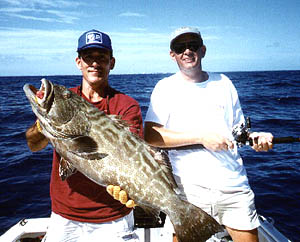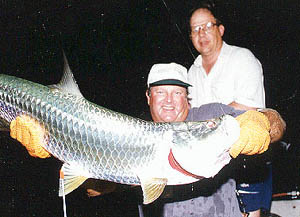 Part
of the
Part
of theFISHING THE FLORIDA KEYS
Series
Florida Keys Fishing Instruction
 Part
of the
Part
of the
FISHING THE FLORIDA KEYS
Series
 Summertime in the Florida Keys...somehow that leisurely pace for which the Keys is so
famous seems to slow down even more so at this time of the year. Yet, summer
fishing in the Keys is anything but slow. Great fishing opportunities exist at this time,
as evidenced by the number of Floridians who do their summer vacation thing in the Keys.
Summertime in the Florida Keys...somehow that leisurely pace for which the Keys is so
famous seems to slow down even more so at this time of the year. Yet, summer
fishing in the Keys is anything but slow. Great fishing opportunities exist at this time,
as evidenced by the number of Floridians who do their summer vacation thing in the Keys.
Are the anglers who consistently do well down here in the summer just luckier than the rest? While chance does have it's place in fishing, there are some general fishing principles which, if followed, can definitely tip the odds in one's favor. So without further fanfare I present to you, "The Fivefold Path For Finer Summer Fishing."
1. BE PREPARED - Semper paratus (always prepared) is the motto
of the U.S Coast Guard, and should be the motto of every serious angler as well. For
example, reef fishermen can save themselves a lot of downtime spent rerigging, by making
up bottom rigs (for grouper, muttons, mangroves) and flatline rigs (for yellowtail) well
before the trip. This is especially important during the summer because so much
fishing takes place at night. Trying to hastily tie up rigs in the dark with wet,
slimy hands during a hot bite of fish can be a nightmare.
Dolphin fishermen can take a lesson here too. There are those summer days offshore
when fishing is somewhat slow (especially on the July and August full moon). During
times like these, a day can be saved in one flurry of activity if the crew is prepared.
There should be plenty of prerigged baits and spare rigs (for both trolling and
casting). In addition, the bait for chumming and casting to dolphin should be cut up
before the action starts.
Summer flats fishing down here is much like Forrest Gump's box of chocolates...you never
know what your going to get. When working some of the deeper flats, I'll often have
a 10 lb. outfit baited with a small shrimp-tipped jig for bonefish, a 12 lb. outfit with a
silver dollar-size crab for permit, another 12 lb. outfit with a live pinfish for shark
and barracuda, and a 20 lb. outfit with a heavy mono shock leader and a crab for tarpon.
My anglers often look like whirling dervishes up on the casting platform as they
hastily switch from one rod to the next.
2. BE OPPORTUNISTIC - Florida Keys fishing is full of surprises.
Quite often a large fish will suddenly appear within casting range, offering a brief
moment (a window of opportunity) in which they can be caught. For example, large
dolphin sometimes show up right behind the boat while anglers are in the middle of bailing
schoolie dolphin with casting tackle. The big guys may not eat the cut bait or even
a whole ballyhoo, but they're usually a sucker for a livebait. By having an extra
rod (we'll call it your "opportunity rod") prerigged with a casting leader and a
small live pinfish or grunt kept in a bucket, you can react instantly to the opportunity
and fire out a "livey" to that fish.
Each summer, a good number of blue marlin are caught during a schoolie bailing session because someone in the boat had the presence of mind to prerig a fifty pound outfit with a heavy duty live bait rig so a schoolie dolphin could be slapped on the hook and fired out immediately to the marlin.
Pesky barracudas can be "removed" from a chumline meant for yellowtail and mangroves by having a light wire leader on the opportunity rod. No need to kill that 'cuda that's been chomping on your snappers; once caught and released, he'll have had enough excitement for one day and will leave your chumline.
The two most important elements to the opportunity rod are:
Speed...Your window of opportunity may be small at best so get the bait to the fish fast before it leaves.
Presentation... Shy fish need shy gear. Keep the leaders as light as possible and the hooks and swivels small and dark colored.
Also remember, it's impossible to be opportunistic without first being prepared. The
best description of success I've ever heard is that it's when preparation collides with
opportunity.
3. BE FLEXIBLE- Too many fishermen are caught up in the angling version
of the "one trick pony." That is, they've got one type of fishing in mind when
they leave the dock, and by golly that's what they're going to do. Successful
fishermen know that a given tactic won't work every day, so they adjust their tactics in
order to catch fish. Dolphin aren't biting? Ever think of targeting those
tasty tripletails laying up under floating debris? A light (8-10 lb.) spinning rod,
a few small hooks or jigs, and some shrimp or squid should do the trick. Or maybe
try some deep dropping for snowy grouper and tilefish. Or try some light-tackle
casting at those schools of skipjacks that are busting the surface.
Yellowtail aren't biting? Try some deep water (100-200 ft. ) bottom fishing with
livebait. Or some deep jigging on the drift. Or trolling plugs deep on the
patch reefs. The point is, don't be afraid to change gears.
 4. BE
EXPERIMENTAL- One of the most successful tournament flats guides in the Florida
Keys once told me that he spends a portion of each trip trying new flats on varying tides
and weather conditions. Believe me, it has paid off for him and it will for you
too. Not only will this put a few more pages into your "piscatorial
playbook," but it will keep you from beating your "pet spots" to a pulp by
hammering them day after day. Get out of the rut!
4. BE
EXPERIMENTAL- One of the most successful tournament flats guides in the Florida
Keys once told me that he spends a portion of each trip trying new flats on varying tides
and weather conditions. Believe me, it has paid off for him and it will for you
too. Not only will this put a few more pages into your "piscatorial
playbook," but it will keep you from beating your "pet spots" to a pulp by
hammering them day after day. Get out of the rut!
Other applications of this principle might include varying your trolling or retrieve speed and depths, or varying your baits or lures, etc.
Let me share two applications whereby experimenting has worked for me. Years ago, I used to think night fishing for snappers was only done on the reef. Then one evening I tried it out in Florida Bay; we beat our daytime catches of mangrove snapper by nearly a 2 to 1 margin...and the average size of the night-caught mangos was considerably larger as well.
While running from spot to spot in the bay or out on
the reef, I seldom run a direct compass course. Instead, I will run off course
as much as a mile just to cover new ground. By doing this, I occasionally run over a
ledge or wreck that I would have otherwise missed by following the same straightline
course day after day. The bottom line is that being experimental is what opens us up
to new discoveries.
5. BE OBSERVANT- Did you know that fish talk? They do.
Whether it's that yellowtail snapper trying to tell you that your leader is too visible,
or those blackfin tuna calling for you to change the colors of those feathers to more
closely match the squid they're spitting out into your fishbox. Maybe it's those
tarpon at the bridge telling you they're feeling a little too sluggish to eat that mullet,
but that a deep drifted crab would really hit the spot.
Be sensitive to what the fish are trying to
"tell" you, and be sensitive to the conditions around you as well. Perhaps
the best piece of advice ever handed down to me was from the late Capt. Elmo Capo who
said, "Always fish your conditions." Simply stated, that means fish for the
species for which the conditions are best suited.
6. BE PATIENT- I know...there were only supposed to be five points. This
one's free!
Sometimes you have to set all the techniques and fancy
tricks aside... and just "wait 'em out." Wish I had a quarter for every
time I got ants in my pants and gave up on a fishing spot...only to find out later from a
buddy that the fish "ate it up" shortly after I left. Sometimes you have
to go with your gut feelings about a spot, and frankly, sometimes your gut is going to be
wrong! So be patient with yourself too. It's a bit ironic that the most
fascinating aspect of the entire sportfishing process may be the amount of value we place
on our ignorance of the outcome (you may want to read that again to let it sink in).
Your not going to "crush 'em" every day so cut yourself a little slack
and have some fun. But by following the principles outlined above, you should start
turning some of those summer "dog day" busts into blasts.
MORE FREEBIES...Here are a few other diddies that anglers should find
helpful. Those who wish to do battle out on the water during the summer months must
possess a healthy respect for the effects of the sun and heat. Some vital items that
no angler can afford to be without are a powerful sunscreen, a wide brimmed hat, polarized
sunglasses, and plenty of water (soda and beer aren't going to cut it out here gang).
The light, loose fitting, long-sleeved shirts and long-legged pants that have
become so popular with the flats fishing crowd are actually excellent for all types of
summer fishing down here. You'll stay far cooler in these than in shorts and a tee shirt
(though your laundry bill may escalate if you find yourself in regular "bailing
sessions" with schoolie dolphin.)
![]()
About the Author
 Captain Buddy LaPointe is a cum
laude graduate of Pensacola Christian College, and has over 20 years experience charter
fishing in the Florida Keys. He has been featured on Mark Sosin's Saltwater
Journal, (seen weekly on national television), and in the Outdoors section
of the Miami Herald. In addition, Capt. Buddy has written
numerous articles for Sport Fishing Magazine, Saltwater
Sportsman, Fishing the Florida Keys, and the Florida
Keys Keynoter.
Captain Buddy LaPointe is a cum
laude graduate of Pensacola Christian College, and has over 20 years experience charter
fishing in the Florida Keys. He has been featured on Mark Sosin's Saltwater
Journal, (seen weekly on national television), and in the Outdoors section
of the Miami Herald. In addition, Capt. Buddy has written
numerous articles for Sport Fishing Magazine, Saltwater
Sportsman, Fishing the Florida Keys, and the Florida
Keys Keynoter.
![]()
SITE LAST UPDATED 9/9/99
|
HOMEPAGE | ARTICLES | EMAIL/FEEDBACK |